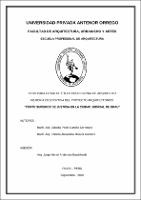Mostrar el registro sencillo del ítem
Corte superior de justicia en la ciudad judicial de Grau
| dc.contributor.advisor | Anderson Burckhardt, Jorge Martin | |
| dc.contributor.author | Castillo Coronado, Claudia Paola | |
| dc.contributor.author | Moscol Cardoza, Fabiola Alexandra | |
| dc.creator | Castillo Coronado, Claudia Paola | |
| dc.date.accessioned | 2020-09-29T22:33:19Z | |
| dc.date.available | 2020-09-29T22:33:19Z | |
| dc.date.issued | 2020 | |
| dc.identifier.uri | https://hdl.handle.net/20.500.12759/6610 | |
| dc.description.abstract | La presente tesis surgió del análisis de la problemática generada por el déficit de infraestructura que presenta la Corte Superior de Justicia de Piura, debido al crecimiento de la demanda del servicio judicial y la carencia de ambientes para albergar a todos sus órganos jurisdiccionales. Durante los años 2016-2019, este trabajo ha recopilado información a través de investigación cuantitativa y cualitativa, con datos estadísticos, entrevistas y documentos alcanzados por la misma Corte Superior de Justica. Asimismo, para conocer la realidad a fondo, se amplió la investigación a nivel local, nacional e internacional. Ello nos permitió identificar requisitos arquitectónicos y propios del sector judicial que fueron implementados y cumplidos tanto en aspectos funcionales, estéticos y ambientales, con el fin de crear una estructura con alta rentabilidad, que contribuya al crecimiento del ámbito judicial y se atienda de esta manera todas las necesidades del usuario y la población en general. | es_PE |
| dc.description.abstract | The topic of the following thesis became of interest due to the perceivable lack of infrastructure in the Justice Court of Piura because of the growing demand in judicial services and the scarcity of locations to hold all of its jurisdictional departments. During the period between 2016-2019, this investigation has compiled information of both quantitative and qualitative data, statistics, interviews and documents reached by members of the justice court of Piura itself. Furthermore, in order to deeply understand the case, this investigation was carried up to a local, national and international level. This allowed us to identify the architectural requirements applied in different judicial systems that achieved the functional, esthetic and environmental aspects with the goal of creating infrastructure with high profitability that contributes to the judicial system, covering the necessities of the user and the population in general. | en_US |
| dc.description.uri | Tesis | es_PE |
| dc.format | application/pdf | es_PE |
| dc.language.iso | spa | es_PE |
| dc.publisher | Universidad Privada Antenor Orrego - UPAO | es_PE |
| dc.relation.ispartofseries | MEM_ARQP_020 | |
| dc.rights | info:eu-repo/semantics/openAccess | es_PE |
| dc.source | Universidad Privada Antenor Orrego | es_PE |
| dc.source | Repositorio Institucional - UPAO | es_PE |
| dc.subject | Arquitectura climatológica | es_PE |
| dc.subject | Circulaciones diferenciadas | es_PE |
| dc.title | Corte superior de justicia en la ciudad judicial de Grau | es_PE |
| dc.type | info:eu-repo/semantics/bachelorThesis | es_PE |
| thesis.degree.level | Título Profesional | es_PE |
| thesis.degree.grantor | Universidad Privada Antenor Orrego. Facultad de Arquitectura, Urbanismo y Artes | es_PE |
| thesis.degree.name | Arquitecto | es_PE |
| thesis.degree.discipline | Arquitectura | es_PE |
Ficheros en el ítem
Este ítem aparece en la(s) siguiente(s) colección(es)
-
Arquitectura [415]

